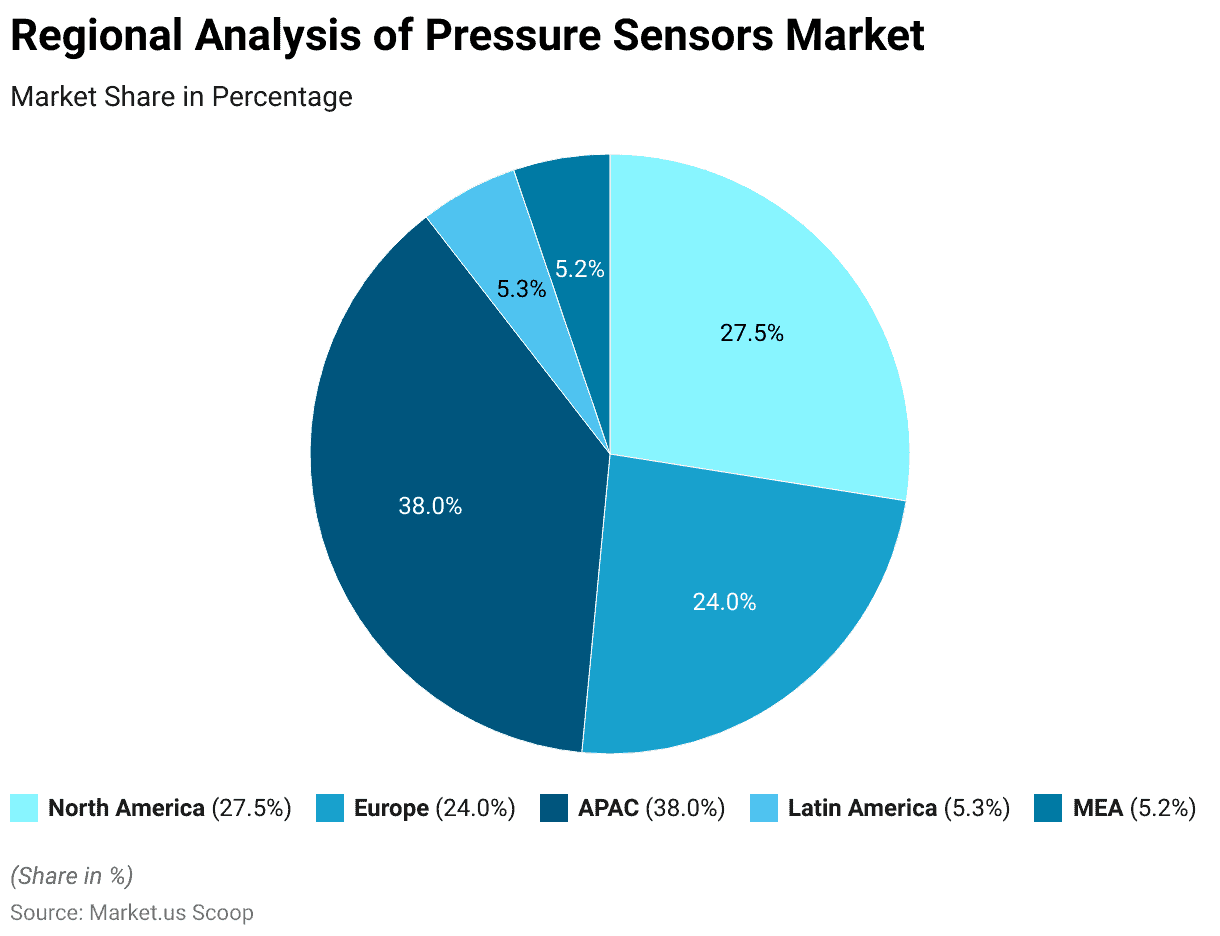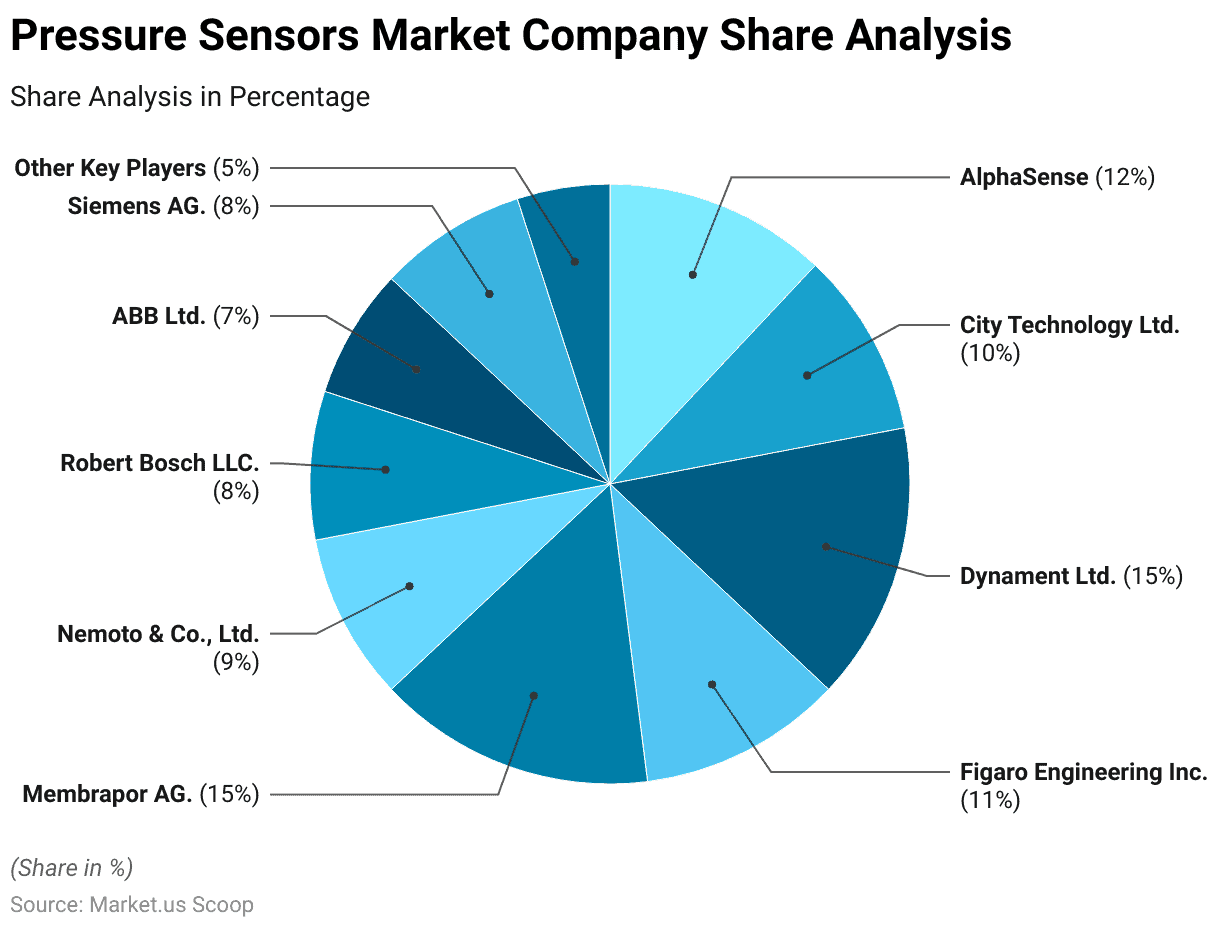Table of Contents
Introduction
According to Pressure Sensors Statistics, Pressure sensors play a vital role in measuring mechanical pressure and converting it into an electric signal. They operate based on principles like piezoresistive, capacitive, or piezoelectric, guaranteeing accurate pressure assessment.
These sensors find application in several industries, such as automotive, healthcare, industrial processes, consumer electronics, and aerospace. They are appreciated for their accuracy, compact dimensions, durability, and ability to offer digital information.
The pressure sensor market is growing due to increased automation and integration with IoT, solidifying their significance as essential tools for supervising and controlling processes in various sectors.
Editor’s Choice
- The revenue of the global pressure sensors market is on a consistent upward trajectory at a CAGR of 8.4%.
- In 2023, the global pressure sensors market generated a revenue of USD 16 billion.
- APAC emerges as the dominant force in the global market, capturing the largest share at 38.0%.
- Dynament Ltd. and Membrapor AG. both hold a substantial 15% market share, showcasing their prominent positions in the pressure sensor market.
- An absolute sensor with a 10mV/V output yields a 0 – 50 mV output with a 5.0 VDC supply. These sensors are usually minimal, with pads or legs suitable for circuit board soldering.
- Optical pressure sensors have a measurement range spanning from 0 to 100 bar, boasting a remarkable resolution of 0.1% of the full scale.
- Capacitive sensors are capable of measuring pressures from vacuum levels (2.5 mbar or 250 Pa) to high pressures up to approximately 10,000 psi (70 MPa), making them suitable for both lower-pressure applications and moderately challenging environments.
Global Pressure Sensors Market Overview
Global Pressure Sensors Market Size
- The revenue of the global pressure sensors market is on a consistent upward trajectory at a CAGR of 8.4%, as indicated by the data from 2022 to 2032.
- In 2022, the market generated a revenue of USD 15 billion, which steadily increased to USD 16 billion in 2023, reflecting a promising start.
- The growth is expected to accelerate further, with revenues reaching USD 26 billion in 2029, USD 28 billion in 2030, and a substantial USD 30 billion in 2031.
- By 2032, the global pressure sensors market is forecasted to achieve a revenue milestone of USD 33 billion, indicating robust growth and significant opportunities within the industry.

Regional Analysis of Pressure Sensors Market
- North America commands a substantial portion of the market share, accounting for 27.5%.
- Europe follows closely behind with a market share of 24.0%.
- APAC emerges as the dominant force in the global market, capturing the largest share at 38.0%.
- Latin America contributes a relatively smaller market share of 5.3%.
- While this percentage may appear modest in comparison to other regions, it still represents a significant market presence.
- MEA accounts for a similar market share of 5.2%.

Key Players in the Pressure Sensors Market
- Dynament Ltd. and Membrapor AG. both hold a substantial 15% market share, showcasing their prominent positions in the pressure sensor market. These companies are recognized for their advanced sensor technologies and innovative solutions.
- AlphaSense secures a noteworthy 12% market share, signifying its significant role in the industry. The company’s focus on cutting-edge sensor technology and its commitment to providing reliable solutions have solidified its reputation.
- City Technology Ltd. holds a respectable 10% market share. The company specializes in gas sensors, including those used in pressure-sensing applications.
- Figaro Engineering Inc. contributes 11% of the market share. The company is known for its expertise in gas and chemical sensors, including pressure sensors.
- Both Robert Bosch LLC. and Siemens AG. hold 8% of the market share each. These globally recognized conglomerates have diversified business portfolios that include pressure sensor technology.
- Nemoto & Co., Ltd. and ABB Ltd. maintain notable positions with 9% and 7% market shares, respectively. Nemoto is renowned for its gas sensors, including those used in pressure-sensitive applications.

Types of Pressure Sensors
Absolute Pressure Sensors
- For measuring air pressure, especially in applications like weather barometric readings and altimeters, absolute pressure sensors are the go-to choice.
- They establish absolute measurements by comparing the target pressure to the known pressure of an absolute vacuum, similar to measuring temperature in Kelvin, starting from 0 °K.
- An absolute sensor with a 10mV/V output yields a 0 – 50 mV output with a 5.0 VDC supply. These sensors are usually minimal, with pads or legs suitable for circuit board soldering.
- In contrast, a ‘transducer’ is a comprehensive sensor with built-in signal conditioning for direct use in industrial settings.
- Typically, it provides a voltage output representing pressure, often within the 0 – 10V range, or generates an alternating signal in the 1 – 6 kHz range in some cases.
Piezoelectric Pressure Sensors
- Piezoelectricity is the generation of electric charge in specific materials when subjected to mechanical stress.
- Piezoelectric pressure sensors utilize this phenomenon by measuring the voltage produced across a piezoelectric element due to applied pressure. These sensors are highly durable and find extensive use in various industrial applications.
- Moreover, engineered ceramics can be crafted with the necessary polarization to render them piezoelectric. These ceramics offer greater sensitivity than natural crystals. Even a minimal 0.1% deformation can generate a valuable output.
- The output maintains linearity across a broad range, usually spanning from 0.7 KPa to 70 MPa (0.1 to 10,000 psi) with approximately 1% accuracy.
MEMS Pressure Sensors
- Microelectromechanical systems (MEMS) devices merge tiny mechanical and electronic parts onto a silicon chip.
- The same manufacturing methods used for creating transistors and other components in integrated circuits (ICs) can also be applied to build mechanical elements like springs, flexible membranes, vibrating structures, valves, gears, and levers.
- This technology enables the production of various sensors, including various types of pressure sensors.
- It allows for the integration of precise sensors, robust processing, and wireless communication (e.g., Wi-Fi or Bluetooth) within a single IC.
Optical Pressure Sensors
- The optical pressure sensors offer precise pressure measurements with temperature compensation.
- They have a measurement range spanning from 0 to 100 bar, boasting a remarkable resolution of 0.1% of the full scale.
- These sensors exhibit exceptional accuracy, with deviations of less than 1% of the full scale.
- Furthermore, they can accommodate up to 96 measurement points when used with a 16-channel si255, allowing for the connection of six sensors per channel. The pressure inlet port features a G 1/8th thread for secure and reliable pressure input.
Capacitive Optical Sensors
- Capacitive sensors have a broad temperature operating range and can tolerate short-term overpressure conditions effectively.
- They are versatile, and capable of measuring pressures from vacuum levels (2.5 mbar or 250 Pa) to high pressures up to approximately 10,000 psi (70 MPa), making them suitable for both lower-pressure applications and moderately challenging environments.
- These sensors are inherently low-power as they don’t require DC current flow through the capacitor.
Pressure Sensor Reliability and Repeatability
- For most applications, it’s crucial to have a differential pressure sensor that meets high standards of accuracy, repeatability, reliability, and stability.
- The objective is to ensure that HVAC systems operate at peak efficiency with minimal downtime.
- Therefore, pressure measurement instruments are required to incorporate dependable sensor technology capable of detecting even the slightest pressure differences while maintaining accuracy and reliability over time.
- While you may aim to save energy by precisely controlling temperature, the accuracy of the differential sensor plays a pivotal role.
- If the sensor’s accuracy shifts from +/- 0.25% to +/- 1.0% or more at any point, it can disrupt the precise control of the process and lead to increased energy costs.
Latest Trends in Pressure Sensor Technology
- In October 2019, Melexis introduced a specialized pressure sensor integrated circuit (IC) tailored for use in the engine’s EVAP (Evaporative Emission Control) system.
- This relative pressure sensing IC, designed for shallow pressure measurements in automotive contexts, highlights the company’s commitment to advancing hybrid vehicle technology.
- Serving as the central component of the EVAP system, the MLX90821 is capable of detecting even the tiniest vapor leaks.
- In January 2020, the Indian tire manufacturer JK Tire launched a tire pressure monitoring system (TPMS) using TREEL mobile solutions they had acquired earlier. These TREEL sensors are designed to track important tire data, such as pressure and temperature.
Discuss your needs with our analyst
Please share your requirements with more details so our analyst can check if they can solve your problem(s)



